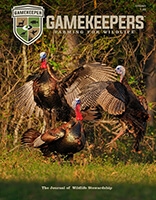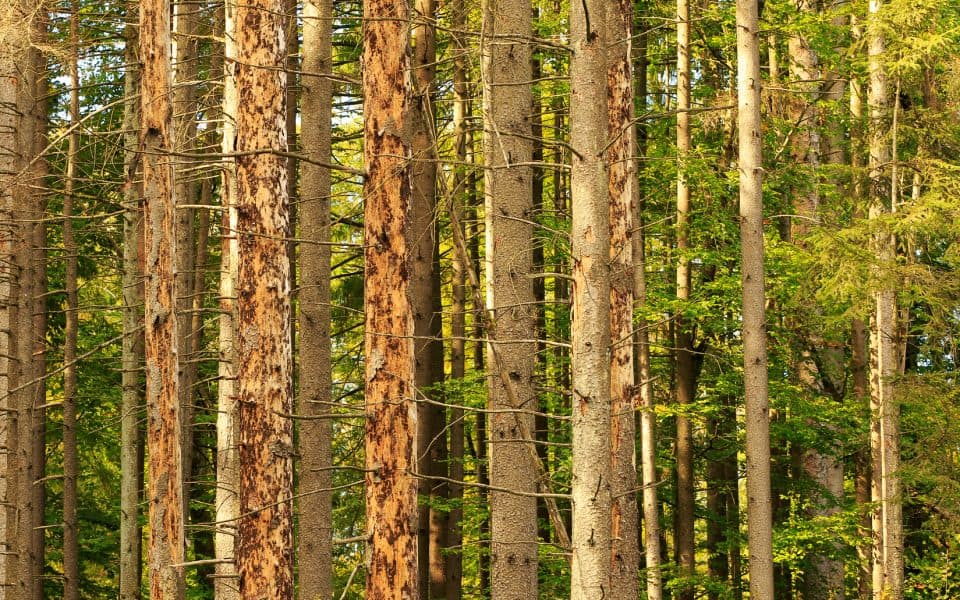Across the country arborists and forestry experts are fielding the same question from property owners, “What’s killing my trees?” The answer is often times two-fold in nature. The actual tree killer was not the initial culprit, but the tree was subjected to any of dozens of stressors; conditions that allow a disease or insect to attack the trees source of life.
Understanding Tree Decline: Stressors and Susceptibility
“It’s usually not the insect or disease that begins the decline. It could be a drought, or compaction, or construction, or flooding, or a combination, etc. that causes stress. Once a tree is stressed it is more attractive to insects or pathogens, much like wolves that go for the easiest and weakest target,” Dudley Phelps of Mossy Oaks Nativ Nursery said. “Tree bark is a very resilient thing, but when the bark is compromised a pathway for infection is introduced.”
The Role of Insects in Tree Death
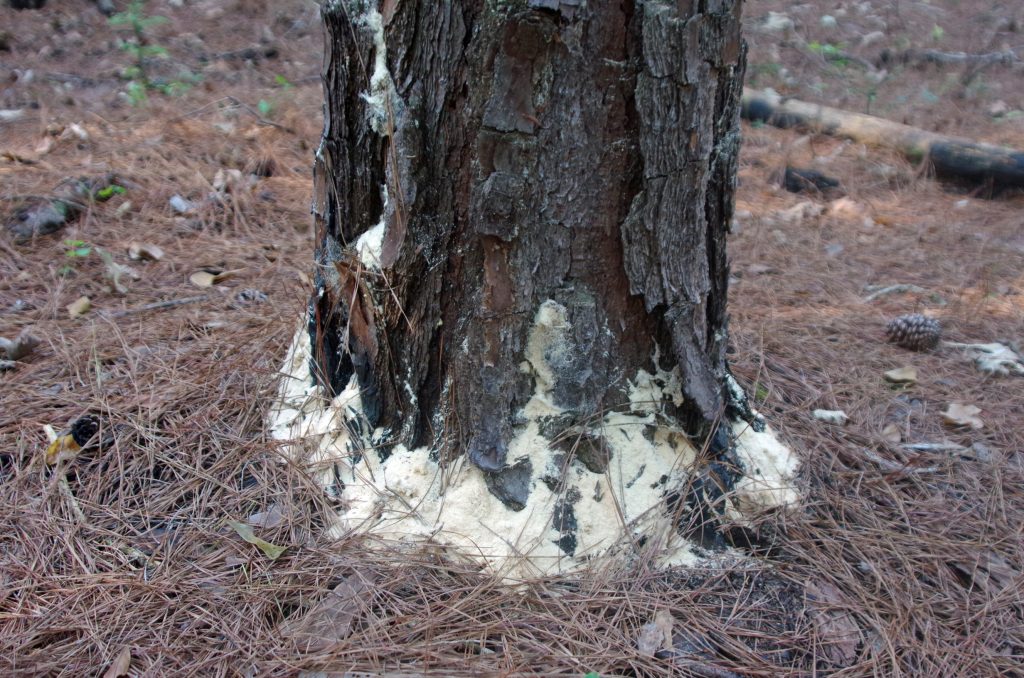
David Hawkins
Pine Beetles: A Destructive Tree Pest
Pine beetles are a common scourge across the country and come in several varieties; Southern Pine Beetles (SPB), Japanese Pine (JPB) Beetles and Ips beetles. Blue dye fungi are often introduced with a beetle attack; you will see this blue color when trees are cut or sawn into lumber. While there are chemical treatments to deter pine beetles, it is not necessarily cost effective. Consulting a professional forester will be the best course of action for the landowner. Experts may recommend cutting, burning or spraying isolated locations. Beetles can be identified by the tracts they make under the bark.
Girdler Beetles: Weakening Tree Health
Girdler beetles (Oncideres cingulate) do not kill trees but reduce the trees ability to thrive by killing entire branches. You may find these dead branches on the ground following windstorms. Notice on the base end of the branch where the girdler has gnawed the circumference of the branch. Collecting and burning these will help eradicate the pest to some degree. Pecans, hickories and persimmons are susceptible. The loss of fruit or mast on that branch is a loss to wildlife.
Common Tree diseases and Their Impact
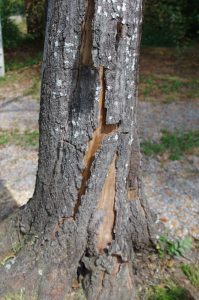
David Hawkins
Oak Wilt: A Deadly Threat to Oak Trees
Oak wilt, (Ceratocystis fagacearum), is a fungal disease that moves through the vascular system (water conducting tissue) of the tree. The fungus spores are carried to the tree by small beetles that feed on sap from fresh wounds. These sap beetles that carry the disease from infected trees are attracted to fresh wounds from storm damage, pruning cuts or other injuries to previously uninfected trees. Once the beetles feed and the fungus moves into the vascular tissue, the tree reacts and tries to wall off the spread of the disease by plugging cells which causes branches to wilt. The disease can also spread from already infected oaks by moving through root grafts between trees of the same species. This is why oak wilt spreads so effectively between nearby trees.
So in summary there are a host of maladies that can cause the demise of your trees. Knowing all these scientific names and such will win you a trivia game at the bait shop or perhaps allow you to impress the family by answering a Jeopardy question, but do nothing in stopping the progression of tree killers.
Natural Causes of Tree Mortality
Aging and Environmental Stressors
At the risk of too much personification, trees are much like people; as they age and their immunity becomes compromised, so the chances are increased that disease and illness will creep into the tree and cause permanent injury and death. And just like humans, it is not always a speedy progression of events. Once a tree is infected, it may not succumb to its illness for several years, even decades. To put it simply, stress factors cause weaknesses in a trees defense mechanisms, so insects and diseases can invade.
Some trees succumb to natural events, such as ageing, lighting, or simply that the species of tree does not have a long life, such as dogwoods and plums. But the best a gamekeeper can do is practice best management practices as set forth by forest professionals.
The Impact of Pollution on Tree Health
Point-source pollution is another difficult to regulate tree killer. Where heavy snow exists and ice is applied to roadways, the snow melt and runoff can be very harmful to deciduous and coniferous trees alike. Not much you can do here but create a buffer, ditch away the runoff and hope for the best.
Best Practices for Tree and Forest Management
The Benefits of Prescribed Burning
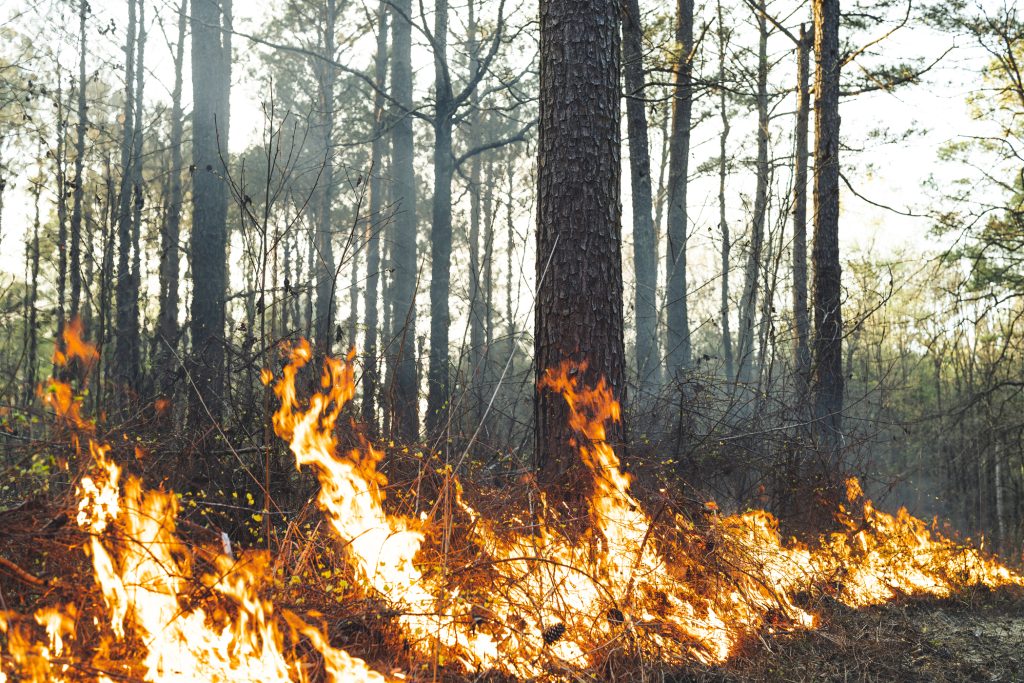
Rob Kinney
Thinning, culling, prescribed burning and creating buffers are just a few management practices that go hand in glove with good forest management and wildlife management. The elimination of invasive species or even less desirable native stock that competes for plant food comes high on the list of Best Forest Management Practices. This is a good time to consult a forest professional. They can be found at the county level (or parish) or even at the state level. Their advice is usually based on university research and they may offer free seminars on forest management. The Mississippi Forestry Commission will help landowners conduct a prescribed burn; the same with a number of other states I contacted.
Many foresters have been critical of using fire in hardwoods because of the potential to reduce timber value. Indeed, most hardwood species are not as resilient to fire as many pine species. However, any tree species can be damaged or killed by fire; it all depends on fire intensity and duration. Although upland hardwoods can be burned without damaging timber, extra precaution is required when timber value is the primary objective, and the effect may not be worth the risk.
The benefits of using prescribed fire in hardwood systems are essentially the same as in pine systems. Fire influences plant community composition and structure, reduces fuels, and recycles nutrients. Thus, prescribed burning can have a tremendous impact on succession of plant and animal communities, quality of wildlife habitat, and susceptibility to wildfire. When burning in hardwood systems, adjust the firing technique and timing to reduce fire intensity to meet objectives.
Prescribed burning in pine stands has been long practiced as a way to enhance wildlife habitat. The fire kills or curtails the undesirable understory, promotes secondary sessional growth of forbs and other beneficial plants and lessens the litter on the forest floor that could cause a much more intense fire. My granddaddy said burning sent the snakes back to Hades, so maybe there’s that too.
Hack-and-Squirt: A Simple Tree Management Technique
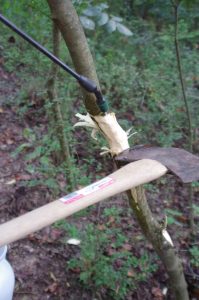
David Hawkins
One of the simplest way to complete this task is with a hack-and-squirt technique. Hack-and-squirt is as simple as it sounds. Hack around the girth of the tree you wish to kill with a hatchet, brush axe or machete, and spray a tree killing chemical into the incisions. There are dozens of chemicals perfect for this application with common ones being 2,4-d, and stronger concentrations of the popular weed killer glyphosate. A search on line or shopping at a farm supply store will be your best bet. Mix the chemical and store in a quart-size spray bottle, I like to use a 1&1/2-gallon sprayer that needs fewer refilling stops. Mixing larger amounts is fine and an old gas can is perfect for transporting on an ATV. Don’t mix more than you intend to use in a couple of days. Wearing rubber gloves and a mask is recommended. Using tree marking tape will allow you to keep up with the trees you wish to save. Timing is important and some sap movement is best when applying tree killers — when the sap is falling is ideal. Consult your local forester for more information.
Unusual Threats to Trees: Wild Hog and Root Rot
Along the lines of bait-shop trivia is this tidbit: Ingestion of infected roots by feral pigs provides a minor vector pathway for kauri dieback disease (Phytophthora agathidicida). You read that correctly, wild hogs can spread root rot that kills your mast-producing hardwoods. Just another good reason to rid the countryside of these voracious invaders. There are dozens of root rot diseases, making it difficult to pinpoint a specific. Some are highly contagious among similar species of weakened trees.
Here’s something I’ll bet you didn’t know; I didn’t. Members of the red oak family will intertwine their roots. No big deal right. But those roots will actually graft to one another carrying sustenance to both trees and spreading disease if either has it. You might want to talk to your trees about this grafting underground (joke).
The Long-Term Effects of Storm Damage on Forests
As the writing deadline for this article approaches, hurricane Helene has just ripped an ugly path through Florida, Georgia, the Carolinas, and Tennessee. Millions of dollars in timber were destroyed. Remaining trees will be stressed due to high wind and water. The residual effect of the storm will be felt by the forestry community for decades to come.
Join our weekly newsletter or subscribe to GameKeepers Magazine.
Your source for information, equipment, know-how, deals and discounts to help you get the most from every hard-earned moment in the field.
